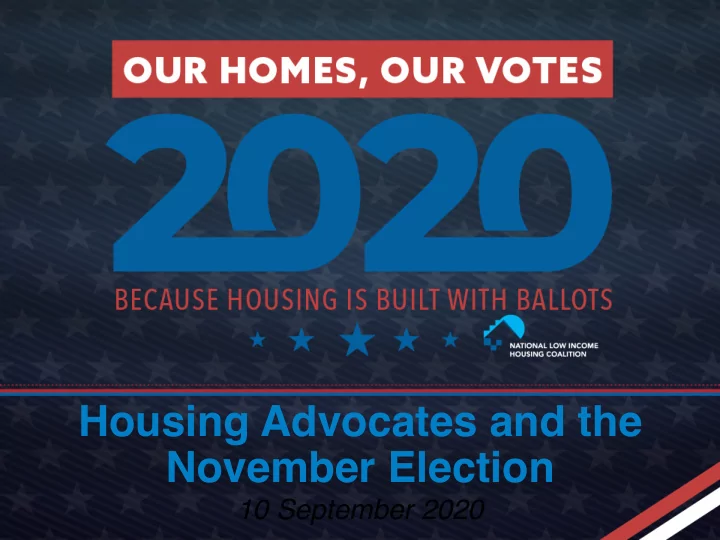

Housing Advocates and the November Election 10 September 2020
Engaging Voters and Candidates Our Homes, Our Votes is NLIHC’s voter engagement effort focusing on increasing voter registration and turnout among low-income housing renters and advocates.
Join as an Affiliate Benefits of Joining Our Homes, Our Votes • Swag package • Use of the logo and images on co-branded materials • Amplification through media engagement • Guidance and assistance from NLIHC staff
Communications Platforms
Template Materials
State-Merged Materials Materials that include state- specific information • Will be available as flyers, posters, and door-hangers • Can be modified to include QR codes • Localized versions with polling locations can be merged as well.
Shifting Rules for Voters Stay aware of what’s happening in your state • Webpage for each state is up at www.ourhomes- ourvotes.org • NLIHC will be updating in an ongoing manner • Share information about activities in your state
Upcoming Training and Discussion Topics 1. Election Day! Getting Out The Vote (October 15, 2020) 2. Holding candidates to their promises (November 19, 2020) Other webinar recordings available at www.ourhomes-ourvotes.org/webinars
Voting without an Address
Initial Observations • An address is important to voting • It determines what district a voter lives in, and which candidates they help select • All states ask for a residential address and a mailing address on registration forms • Options exist for voters without an address • Important for voters who are homeless • Also matters for voters in extremely rural areas who have not been assigned a traditional mailing address • Very common on American Indian tribal lands, and often a significant barrier to voting
The Map Option • 28 states allow voters to draw a map or diagram of where they live • Some states have specific language declaring this option to be for rural voters • Process and instructions vary from state to state • Example 1 – Alaska: Voters who live in rural Alaska may provide the name of the community they live in rather than the residential address • Example 2 – Georgia: Voters are instructed to draw a diagram if they live in an area without house numbers and street names.
Voters Who Are Homeless • Some states specifically address voters who are homeless, rather than indicating their options are mostly for rural voters • Example 1 – Colorado: Voter registration form actually includes a checkbox for voters experiencing homelessness. Allows people who check this box to list a location where they commonly sleep. • Example 2 – Iowa: Registration form includes instructions to “describe where you reside,” for voters without an established address. • Example 3 – Ohio: Allows for a “shelter or other location” to be listed as a residence for people without a fixed location for permanent habitation.
Registration Form FAQs • In some states, there is no solution on the registration form, but there is an FAQ page that discusses important next steps • Example 1 – Delaware: Provides instructions on in-person registration that requires two pieces of paper with a name on it, one of which must have information of an address used on the registration form, even if the address is a shelter. • Example 2 – Minnesota: Provides instructions on registration with described sleeping locations, but also adds that voters without an address will be asked to swear under oath at the polling location that their address is correctly listed. • Example 3 – FAQ describes how voters can register by describing a sleeping location
Best Practices • After reviewing all 50 states, the best methods are: 1. Include clear language on the actual voter registration form that while an address is required, voting address may be a map or description of a place. • This option should include plenty of space for drawing the map 2. The language for voting without an address should specifically include people who are homeless. • A checkbox makes this very clear 3. States should prominently feature on their elections websites the necessary information for voting while experiencing homelessness.
Contact Us
Recommend
More recommend